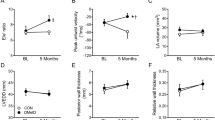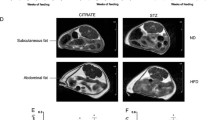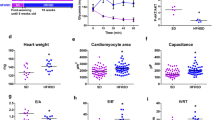Abstract
Cardiomyopathy is a major cause of mortality for both type 1 and 2 diabetic patients. However, experimental analysis of diabetic cardiomyopathy has focused on type 1 diabetes and there are few reports on cardiomyocyte dysfunction in the widely used type 2 diabetic model, db/db. In the current study, we assessed function in isolated ventricular myocytes from type 1 diabetic OVE26 mice and from type 2 diabetic db/db mice. When compared with their respective control strains, both diabetic models showed significant impairment in contractility, as assessed by percent peak shortening, maximal rate of contraction, and maximal rate of relaxation. The calcium decay rate was also significantly reduced in both types of diabetes, but the decrement was much greater in OVE26 myocytes, approx 50% vs only 20% in db/db myocytes. To understand the basis for slow calcium decay in diabetic myocytes and to understand the molecular basis for the quantitative difference between calcium decay in OVE26 and db/db myocytes, we measured cardiac content of the SERCA2a calcium pump. SERCA2a was significantly decreased in OVE26 diabetic myocytes but not reduced at all in db/db myocytes. The reduction of SERCA2a in OVE26 myocytes was completely prevented by overexpression of the antioxidant protein metallothionein, confirming that oxidative stress is an important component of diabetic cardiomyopathy. The current results demonstrate that though contractility is impaired in individual myocytes of db/db hearts and deficits are similar to what is seen in a severe model of type 1 diabetes, impairment in calcium reuptake is less severe, probably as a result of maintenance of normal levels of SERCA2a.
Similar content being viewed by others
References
Rubler, S., Dlugash, J., Yuceoglu, Y.Z., Kumral, T., Branwood, A.W., and Grishman, A. (1972). New type of cardiomyopathy associated with diabetic glomerulosclerosis. Am. J. Cardiol. 30:595–602.
Kannel, W.B., Hjortland, M., and Castelli, W.P. (1974). Role of diabetes in congestive heart failure: the Framingham study. Am. J. Cardiol. 34:29–34.
Shehadeh, A. and Regan, T.J. (1995). Cardiac consequences of diabetes mellitus. Clin. Cardiol. 18:301–305.
Uusitupa, M.I., Mustonen, J.N., and Airaksinen, K.E., (1990). Diabetic heart muscle disease. Ann. Med. 22: 377–386.
Tomlinson, K.C., Gardiner, S.M., Hebden, R.A., and Bennett, T. (1992). Functional consequences of streptozotocin-induced diabetes mellitus, with particular reference to the cardiovascular system. Pharmacol. Rev. 44:103–150.
Duan, J., Zhang, H.Y., Adkins, S.D., Ren, B.H., Norby, F.L., Zhang, X., et al. (2003). Impaired cardiac function and IGF-Iresponse in myocytes from calmodulin-diabetic mice: role of Akt and RhoA. Am. J. Physiol. Endocrinol. Metab. 284:E366-E376.
Ye, G., Metreveli, N.S., Ren, J., and Epstein, P.N. (2003). Metallothionein prevents diabetes-induced deficits in cardiomyocytes by inhibiting reactive oxygen species production. Diabetes 52:777–783.
Wyse, B.M. and Dulin, W.E. (1970). The influence of age and dietary conditions on diabetes in the db mouse. Diabetologia 6:268–273.
Belke, D.D., Larsen, T.S., Gibbs, E.M., and Severson, D.L. (2000). Altered metabolism causes cardiac dysfunction in perfused hearts from diabetic (db/db) mice. Am. J. Physiol. Endocrinol. Metab. 279:E1104-E1113.
Severson, D.L., Larsen, T.S., and Belke, D.D. (1999). Cardiac function in perfused hearts from diabetic and transgenic mice. Winnipeg International Conference on Diabetes and Cardiovascular Disease, S50.
Aasum, E., Belke, D.D., Severson, D.L., Riemersma, R.A., Cooper, M., Andreassen, M., and Larsen, T.S. (2002). Cardiac function and metabolism in Type 2 diabetic mice after treatment with BM 17.0744, a novel PPAR-alpha activator. Am. J. Physiol. Heart Circ. Physiol. 283:H949-H957.
Periasamy, M. and Huke, S. (2001). SERCA pump level is a critical determinant of Ca(2+)homeostasis and cardiac contractility. J. Mol. Cell. Cardiol. 33:1053–1063.
Pieske, B., Maier, L.S., and Schmidt-Schweda, S. (2002). Sarcoplasmic reticulum Ca2+ load in human heart failure. Basic Res. Cardiol. 97(Suppl. 1):I63-I71.
Meyer, M., Schillinger, W., Pieske, B., Holubarsch, C., Heilmann, C., Posival, H., et al. (1995). Alterations of sarcoplasmic reticulum proteins in failing human dilated cardiomyopathy. Circulation 92:778–784.
Ganguly, P.K., Pierce, G.N., Dhalla, K.S., and Dhalla, N.S. (1983). Detective sarcoplasmic reticular calcium transport in diabetic cardiomyopathy. Am. J. Physiol. 244:E528-E535.
Teshima, Y., Takahashi, N., Saikawa, T., Hara, M., Yasunaga, S., Hidaka, S., et al. (2000). Diminished expression of sarcoplasmic reticulum Ca(2+)-ATPase and ryanodine sensitive Ca(2+) channel mRNA in streptozotocin-induced diabetic rat heart. J. Mol. Cell. Cardiol. 32:655–664.
Epstein, P.N., Overbeek, P.A., and Means, A.R. (1989). Calmodulin-induced early-onset diabetes in transgenic mice. Cell 58:1067–1073.
Liang, Q., Carlson, E.C., Donthi, R.V., Kralik, P.M., Shen, X., and Epstein, P.N. (2002). Overexpression of metallothionein reduces diabetic cardiomyopathy. Diabetes 51:174–181.
Munch, G., Bolck, B., Hoischen, S., Brixius, K., Bloch, W., Reuter, H., et al. (1998). Unchanged protein expression of sarcoplasmic reticulum Ca2+-ATPase, phospholamban, and calsequestrin in terminally failing human myocardium. J. Mol. Med. 76:434–441.
Ye, G., Metreveli, N.S., Donthi, R.V. Xia, S., Xu, M., Carlson, E.C., et al. (2004). Catalase protects cardiomyocyte function in models of type 1 and type 2 diabetes. Diabetes 53:1336–1343.
Ren, J., Sowers, J.R., Walsh, M.F., and Brown, R.A. (2000). Reduced contractile response to insulin and IGF-I in ventricular myocytes from genetically obese Zucker rats. Am. J. Physiol. Heart Circ. Physiol. 279:H1708-H1714.
Belke, D.D., Swanson, E.A., and Dillmann, W.H. (2004). Decreased sarcoplasmic reticulum activity and contractility in diabetic db/db mouse heart. Diabetes 53:3201–3208.
Bidasee, K.R., Zhang, Y., Shao, C.H., Wang, M., Patel, K.P., Dincer, U.D., et al. (2004). Diabetes increases formation of advanced glycation end products on Sarco(endo) plasmic reticulum Ca2+-ATPase. Diabetes 53:463–473.
Clark, R.J., McDonough, P.M., Swanson, E., Trost, S.U., Suzuki, M., Fukuda, M., et al. (2003). Diabetes and the accompanying hyperglycemia impairs cardiomyocyte calcium cycling through increased nuclear O-GlcNAcylation. J. Biol. Chem. 278:44230–44237.
Pelzer, T., Jazbutyte, V., Arias-Loza, P.A., Segerer, S., Lichtenwald, M., Law, M.P., et al. (2005). Pioglitazone reverses down-regulation of cardiac PPARgamma expression in Zucker diabetic fatty rats. Biochim. Biophys. Res. Commun. 329:726–732.
Marfella, R., D'Amico, M., Di, F.C., Piegari, E., Nappo, F., Esposito, K., et al. (2002). Myocardial infarction in diabetic rats: role of hyperglycaemia in infarct size and early expression of hypoxia-inducible factor 1. Diabetologia 45:1172–1181.
Nishikawa, T., Edelstein, D., Du, X.L., Yamagishi, S., Matsumura, T., Kaneda, Y., et al. (2000). Normalizing mitochondiral superoxide production blocks three pathways of hyperglycaemic damage. Nature 404:787–790.
Marra, G., Cotroneo, P., Pitocco, D., Manto, A., Di Leo, M.A., Ruotolo, V., et al. (2002). Early increase of oxidative stress and reduced antioxidant defenses in patients with uncomplicated type 1 diabetes: a case for gender diffrence. Diabetes Care 25:370–375.
Trost, S.U., Belke, D.D., Bluhm, W.F., Meyer, M., Swanson, E., and Dillmann, W.H. (2002). Overexpression of the sarcoplasmic reticulum Ca(2+)-ATPase improves myocardial contractility in diabetic cardiomyopathy. Diabetes 51:1166–1171.
Additional information
The first two authors contributed equally to this work.
An erratum to this article is available at http://dx.doi.org/10.1385/CT:6:1:79.
Rights and permissions
About this article
Cite this article
Kralik, P.M., Ye, G., Metreveli, N.S. et al. Cardiomyocyte dysfunction in models of type 1 and type 2 diabetes. Cardiovasc Toxicol 5, 285–292 (2005). https://doi.org/10.1385/CT:5:3:285
Received:
Revised:
Accepted:
Issue Date:
DOI: https://doi.org/10.1385/CT:5:3:285




